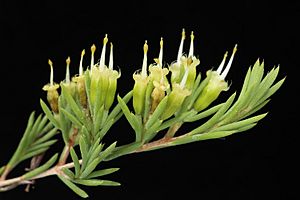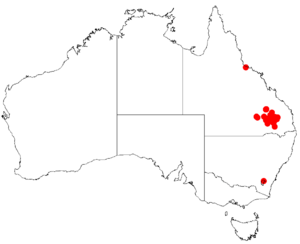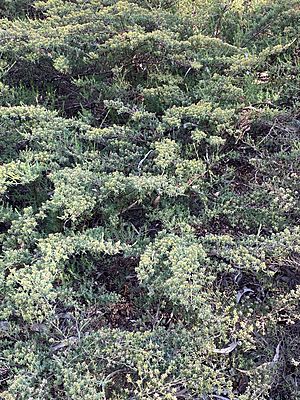Homoranthus melanostictus facts for kids
Quick facts for kids Homoranthus melanostictus |
|
|---|---|
 |
|
| Homoranthus melanostictus in the ANBG | |
| Scientific classification | |
| Genus: |
Homoranthus
|
| Species: |
melanostictus
|
 |
|
| Occurrence data from AVH | |
Homoranthus melanostictus is a special plant that belongs to the myrtle family, called Myrtaceae. You can only find it in eastern Australia, which means it is endemic there.
This plant has leaves that can be shaped like cylinders or be a bit flat. They also have tiny black dots filled with oil! It grows up to six yellow flowers. These flowers grow where the leaves meet the stem, which is called a leaf axil, usually near the ends of the branches.
Contents
What Does Homoranthus melanostictus Look Like?
The Homoranthus melanostictus plant usually grows to be about 0.25 m (0.8 ft) tall. It spreads out wide along the ground, but its branches stand up straight at their tips.
How Homoranthus melanostictus Got Its Name
The plant Homoranthus melanostictus was first given its scientific name in 1991. Two scientists, Lyndley Craven and S.R Jones, officially described it in a science journal called Australian Systematic Botany.
The second part of its name, melanostictus, comes from Ancient Greek words. "Melas" means "black" or "dark", and "stiktos" means "spotted" or "dappled". This name probably refers to the black oil dots found on its leaves!
Where Homoranthus melanostictus Lives
You can find Homoranthus melanostictus growing in south-eastern Queensland, Australia. It spreads from the north-west of Taroom down to the south of Tara.
This plant likes to grow in sandy soils. It is often found in areas with scattered trees and shrubs, like a shrubby woodland, or in open areas with low-growing plants, called heathland.
Is Homoranthus melanostictus Protected?
This plant is quite common and can be found in many places. However, it is not very well protected in special nature reserves. This means that not many areas where it grows are set aside to keep it safe.


